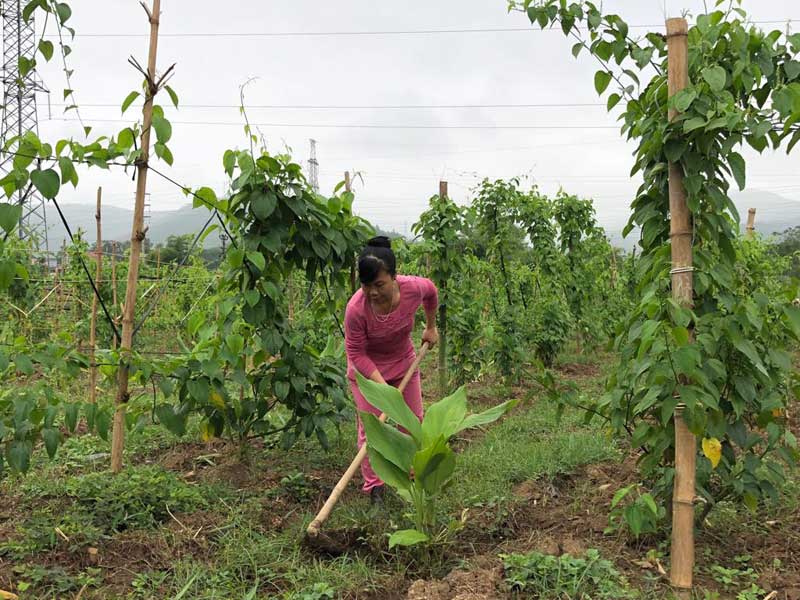
(HBO) - According to Ms. Pham Huyen Lieu, the Head of Ky Son Commune Agricultural and Forestry Encouragement Station, planting medicinal plants (sachi trees with red turmeric) has brought the higher income at 2- 7 times in the first year and 8-20 times from the second year onwards compared with planting popular local plants. In addition, this helps the formation of concentrated production areas. The link between producing and consuming sachi-red turmeric, which was implemented by the district from 2017 to 2018, has shown the efficiency and has become the basis of multiplication in the area.
 The household in Mo village, Dan Ha commune
(Ky Son) participates in expanding the area of sachi planting with red turmeric
and consumption in 2017 - 2018.
The household in Mo village, Dan Ha commune
(Ky Son) participates in expanding the area of sachi planting with red turmeric
and consumption in 2017 - 2018.
Six households participating in 2018 in the
direction of linking the production and consumption of sachi with red turmeric
with the area of 6 hectares. The project of linking - selling products in the
value chain in 2017 - 2018 of the district was assigned to the Agricultural –
Forestry Encouragement Station as the investor; INCA Vietnam joint Stock
Company is the implementing unit; the People's Committees of the Project – Area
Communes are the coordinating units. The funding is from the national target
program to build new rural area with a total capital of over 850 million VND,
400 million VND of which is from the State budget, the local people contributed
over 300 million VND, the enterprise contributed nearly 140 million VND. The
households participating in the project will be supported 50% of the value of
sachi seeds, 80% of the value of the turmeric seeds. They were provided with
technical training and the enterprises provided 100% of the fertilizer money
and 50% of seed money. With the application of advanced technology in plant
care and preservation, the cultivation of sachi with red turmeric with the
oganic method using no chemical fertilizers and herbicides, the model has
contributed to protect the ecological environment, greening the bare land,
increasing the efficiency of land use, diversifying agricultural products,
creating sustainability in production.
According to the investigation and evaluation
of the model in the first year, the average yield of sachi with red turmeric
was 180-300 million VND / hectare / year (including leaves, fruits and
turmeric). Meanwhile, on the same acreage, cassava plantation has an average
income of 30 million VND / hectare / year or 80 million VND / hectare / year
with arrowroot plantation.
According to data from the Hoa Binh Provincial Party Committee, the industrial production index for the first six months of 2025 is estimated to have increased by 20% compared to the same period last year. This marks the highest year-on-year growth rate for this period since 2020.
In the first six months of 2025, Hoa Binh province’s export turnover was estimated at 1.145 billion USD, marking an 18.11% increase compared to the same period in 2024. Import turnover was estimated at $ 804 million, a 17.15% increase, which helped the province maintain a positive trade balance.
The lives of the ethnic minority farmers in Tan Lac district have gradually improved thanks to the new directions in agricultural production. This is a testament to the collective strength fostered through the professional associations and groups implemented by various levels of the district’s Farmers’ Union.
With the motto the "product quality comes first,” after nearly one year of establishment and operation, Muong village’s Clean Food Agricultural and Commercial Cooperative, located in Cau Hamlet, Hung Son Commune (Kim Boi district), has launched reputable, high-quality agricultural products to the market that are well-received by consumers. The products such as Muong village’s pork sausage, salt-cured chicken, and salt-cured pork hocks have gradually carved out a place in the market and they are on the path to obtaining the OCOP certification.
In the past, the phrase "bumper harvest, rock-bottom prices" was a familiar refrain for Vietnamese farmers engaged in fragmented, small-scale agriculture. But today, a new spirit is emerging across rural areas of Hoa Binh province - one of collaboration, organisation, and collective economic models that provide a stable foundation for production.
Maintaining growing area codes and packing facility codes in accordance with regulations is a mandatory requirement for agricultural products to be eligible for export. Recently, the Department of Agriculture and Environment of Hoa Binh province has intensified technical supervision of designated farming areas and packing facilities to safeguard the "green passport" that enables its products to access international markets.



 The household in Mo village, Dan Ha commune
(Ky Son) participates in expanding the area of sachi planting with red turmeric
and consumption in 2017 - 2018.
The household in Mo village, Dan Ha commune
(Ky Son) participates in expanding the area of sachi planting with red turmeric
and consumption in 2017 - 2018.